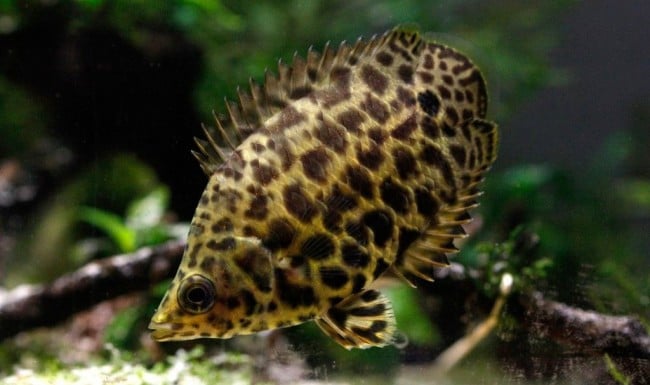- Common Names – Leopard Bushfish, Spotted Climbing Perch, Congo Leaf Fish, Purple Bushfish.
- Scientific Name – Ctenopoma acutirostre

Description
These fish, with their prehistoric looks, have a very strong resemblance to the South American Leaf fish of the genus Polycentrus and Monocirrhus. In reality this is a case of conversant evolution as both the Leopard Bushfish and Leaf fish have evolved a body shape that enables them to mimic leaves and other aquatic debris so naturally that they can blend into the local fauna unseen by potential prey. The bodies of some specimens are lemon-brown with large dark spots whereas the body colours of others are so dark that the spotting becomes almost lost against this background. Fins are best described as short-based. These particular fish are well armed with an array of spines that are present on the hind margins of the gill cover. The average aquarium size for these fish is 15cm.
Origin
Lower and central river basins of the Congo River, where the pH has a value of between 7 and 7.5.
Aquarium Care
Not overly fussy about the pH of their aquarium water. They should be kept at a temperature of around 25 C. They require a spacious aquarium of 90x30x30cm that is provided with as much plant and decor cover as is possible. These fish are nocturnal by nature (as indicated by their large eyes) but, once settled, will be regularly seen out and about at all times, in particular when food is on offer. Remember to follow the airspace rule for labyrinth species by leaving a gap of 2.5cm between the water surface and condensation shield. The condensation shield also helps to keep these fish in their home as they are capable of leaping well clear of the water. Eat any aquarium foods offered. Keeping these fish can be very hit-and-miss as some specimens can be prone to a number of illnesses associated with aquarium fish yet others become long lived aquarium residents.
Companions
Any fish small enough to be swallowed will soon be stalked (although the method of doing so is primitive when compared to that of their Betta picta and Betta falx relatives) and treated as a starter course, soon to be seen disappearing down the unfolding chasm that is the mouth of a Leopard Bushfish. However large characins, Synodontis catfish and large cyprinids make good companions. If you aim to maintain a group of these fish add all the members at one go as, otherwise, the original resident(s) will begin an unseen war of attrition against the newcomers and you will be left with your original Leopard(s) and a lot of upset.
Fin Nipping
Although I have only witnessed this behaviour on one occasion, when a variety of Trichogaster species were their companions, Leopard Bushfish have a reputation for nipping the fins of fellow aquarium occupants.
Breeding
The ‘Discus system’ of obtaining several youngsters from which a compatible pair will, hopefully, form at a future date is often used with the Leopard Bushfish. Although not 100% accurate the sexes are told apart as males have tiny spines on their gill covers.
Although these fish are egg scatterers there are several reports of a tiny bubblenest been used in the proceedings. Once spawning is over the parents should be removed. At this point it is only fair to mention that there are a number of reports of aquarists who have witnessed the spawning of this species but that, by comparison, the number of reports of the fry surviving to the two month old mark are very few. Even when attempts were made to raise only a small number of fry, starting feeding with green water and then moving onto live brine shrimp, it appears that a combination of weakness amongst the fry, suspected sibling cannibalism, a failure to eat in the early stages of life, pollution of the aquarium, problems at the forming of the labyrinth organ and the ever present danger of velvet disease took a huge toll upon their number.
Leave a Reply